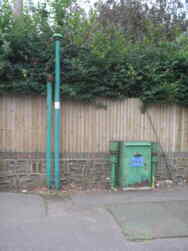|

Gas
Governor Site off Ash Road
|
Gas
Supply today
The coverage of Hartley by mains gas is
still somewhat patchy outside the central area. The Bramblefield
Estate near Longfield Station is all electric, and it has still
not reached the southern end of Church Road, where many households
rely on Calorgas. The number involved probably hasn't
changed since 1984 when the council estimated 271 houses were
not on the mains. The supply of gas is quite complex
today, as the industry is fragmented into a large number of
producers and retailers. Householders locally have a large
number of would be suppliers of electricity, and prices can
be compared at impartial websites like www.uswitch.com.
History
Like electricity,
Dartford had mains gas long before the villages. The Dartford
Gas Company was founded in 1826, and was eventually merged with
the South Suburban Gas Company in 1919. Mains gas was
not extended to Hartley until after the Second World War, although
the parish meeting requested it in 1927 and the Dartford Chronicle of 7 April 1933 did say that the South
Suburban Gas Company was thinking of laying on gas to the village.
In the 1932-3 they presented a bill to Parliament, which
was opposed by Dartford Rural District Council. The council
petitioned parliament against the bill on a number of grounds. They
were concerned that the power to charge people in the Hartley -
Longfield area up to 2¾d above the basic 9½d per therm
would hinder future development. It also objected to a later
proposal in 1935-6 session of parliament because the gas holders
proposed for Darenth, Eynsford and Sutton at Hone would be 120 feet
high. It is unclear whether gas would have come to Hartley
in the later bill. Mains gas did not arrive until sometime
after the war. Certainly by 1961 gas had reached Hartley. Conversion to North Sea Gas occurred in about 1975.
Since March 1997 households in
Kent have been able to change their supplier. The Dartford
Times of 9 January 1997 reported a complaint by a resident of
Pitfield over the sales tactics of one of the new companies
vying for business.
Charges
In 1976 South
Eastern Gas had either a "Gold Star" tariff with a
standing charge of £5.50 per quarter and a cost of 14.1p
per therm (0.478p per KWh); or "General Credit" tariff
with a lower standing charge of £1.25, but higher unit
cost of 21.6p per therm (0.737p per KWh).
Since deregulation comparisons
are harder, and metrication has confused things further as gas
is now charged by the Kilowatt Hour. Seeboard Domestic
Gas tariff for example has two bands, band A is applied to the
first 1,500 KWh or so, and band B to the remainder. This
tariff has no standing charge. Between 2002 and 2006 Band
A has risen from 2.064p per KWh to 3.303p, while Band B has
risen more steeply from 1.184p to 2.078p
|